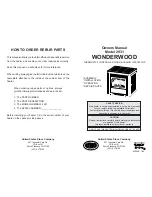
Century FW3000 Installation and Operation Manual
22
Place the door face-down on something soft like a cushion of rags or piece of carpet.
Remove the old gasket from the door by pulling and prying it out with an old screw driver.
Then use the screwdriver to scrape the old gasket adhesive from the door. Now run a 1/4”
(6 mm) bead of high temperature silicone in the door gasket groove. Starting from the
middle of the hinge side, press the gasket into the groove. Do not stretch the gasket as
you place it. Leave the gasket about 1/2” long when you cut it and press the end into the
groove. Tuck any loose fibres under the gasket and into the silicone. Close the door and
do not use the stove for 24 hours.
5.1.3 Replacing the Glass Gasket and/or the Glass
It is a good idea to replace the glass gasket when the door gasket is replaced. The gasket
is flat, adhesive-backed, woven fibreglass. Remove the glass retaining screws (A) and
clips (B). Lift out the glass (C) and pull off the old gasket. This is a good time to clean the
glass thoroughly.
The gasket must be centred on the edge of the glass. To do this easily, peel back a
section of the paper covering the adhesive and place the gasket on a table with the
adhesive side up. Stick the end of the gasket to the middle of one edge, then press the
edge of the glass down onto the gasket, taking care that it is perfectly centred on the
gasket. Peel off more of the backing and rotate the glass and press the next section onto
the gasket. Do not stretch the gasket as you place it. Continue until you get to the start and
trim the gasket to length. Now pinch the gasket to the glass in a U shape, all around the
glass. Reinstall the glass, being careful to centre the glass carefully in the door. Do not
over-tighten the screws. Note that the two main causes of broken door glass are uneven
placement in the door and over-tightening of retaining screws.
















































